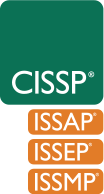Official (ISC)² CISSP Training – Course Outline
Leadership and Operations
This course is designed for information security professionals with deep technical and managerial knowledge and experience to effectively design, engineer and manage the overall security posture of an organization. This training course provides a comprehensive review of information systems security concepts and industry best practices, covering the following eight domains of the CISSP Common Body of Knowledge (CBK®).
Official (ISC)² Online Self-Paced CISSP Training includes:
- Tailored adaptive learning experience
- Interactive, engaging courseware
- Data-driven analytics dashboard for real-time feedback on learner progress
- Robust search functionality to narrow topics
- Sliders to gauge confidence with item answers
- Digital textbook
- Knowledge checks
- Key takeaways
- Interactive content
- Online interactive flash cards
- Practical assessment
- Email learner support
- 24/7/365 chat technical support
- Education guarantee*
Official (ISC)² Online Instructor-Led Training includes:
- Live virtual instruction from an (ISC)² Authorized Instructor
- Virtual collaboration with classmates
- Recordings of live virtual sessions
- Real-world scenarios
- Digital textbook
- Knowledge checks
- Online interactive flash cards
- Practical assessment
- Email learner support
- 24/7/365 chat technical support
- Education guarantee*
*If you don’t pass the exam the first time, access the same training again at no cost to you (within one year from the end of the initial training). Education Guarantee covers the cost of the second course only.
Who Should Attend
The course is ideal for those working in positions such as, but not limited to:
- Chief Information Officer
- Chief Information Security Officer
- Chief Technology Officer
- Compliance Manager/Officer
- Director of Security
- Information Architect
- IT Specialist/Director/Manager
- Information Manager/Information Risk Manager or Consultant
- Network/System Administrator
- Security Architect/Analyst
- Security Consultant
- Security Manager
- Security Systems Engineer/Security Engineer
Course Agenda
- Chapter 1: The Information Security Environment
- Chapter 2: Information Asset Security
- Chapter 3: Identity and Access Management
- Chapter 4: Security Architecture and Engineering
- Chapter 5: Communication and Network Security
- Chapter 6: Software Development Security
- Chapter 7: Security Assessment and Testing
- Chapter 8: Security Operations
- Chapter 9: Putting It All Together
- Chapter 10: CISSP Certification Information
Note: Throughout this course, exam domains may be covered in several chapters. Included in the course is a table indicating where the exam outline objectives are covered within the course. Unique icons are also used through the course materials to identify exam outline objectives.
Course Delivery Methods
Course Objectives
At the end of this course, learners will be able to:
- Apply fundamental concepts and methods related to the fields of information technology and security
- Align overall organizational operational goals with security functions and implementations
- Determine how to protect assets of the organization as they go through their lifecycle
- Leverage the concepts, principles, structures and standards used to design, implement, monitor and secure operating systems, equipment, networks, applications and those controls used to enforce various levels of confidentiality, integrity and availability
- Apply security design principles to select appropriate mitigations for vulnerabilities present in common information system types and architectures
- Explain the importance of cryptography and the security services it can provide in today’s digital and information age
- Evaluate the physical security elements relative to information system needs
- Evaluate the elements that comprise communication and network security relative to information security needs
- Leverage the concepts and architecture that define the associated technology and implementation systems and protocols at Open Systems Interconnection (OSI) model layers 1-7 to meet information security needs
- Determine appropriate access control models to meet business security requirements
- Apply physical and logical access controls models to meet information security needs
- Differentiate between primary methods for designing and validating test and audit strategies that support information security requirements
- Apply appropriate security controls and countermeasures to optimize an organization’s operation function and capacity
- Assess information systems risks to an organization’s operational endeavors
- Determine appropriate controls to mitigate specific threats and vulnerabilities
- Apply information systems security concepts to mitigate the risk of software and systems vulnerabilities through the systems’ lifecycles
 Certified in Cybersecurity
Certified in Cybersecurity  SSCP
SSCP  CISSP
CISSP  CISSP Concentrations
CISSP Concentrations  CCSP
CCSP  CGRC
CGRC  CSSLP
CSSLP 